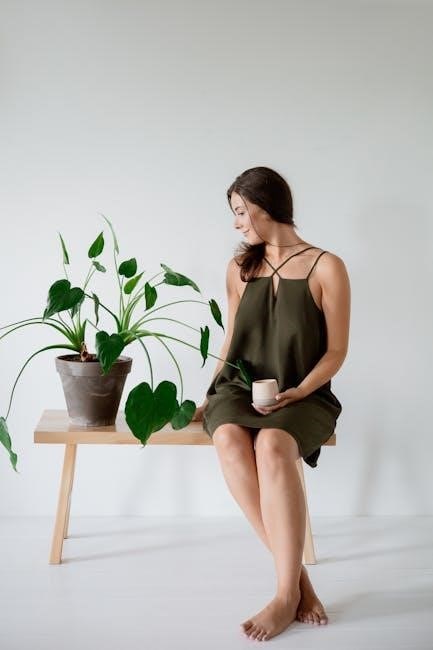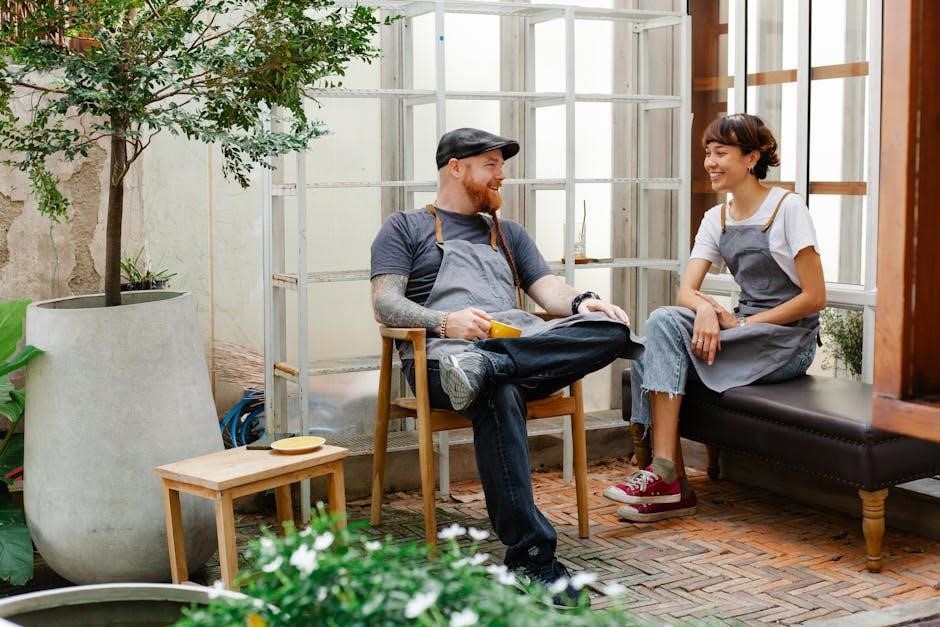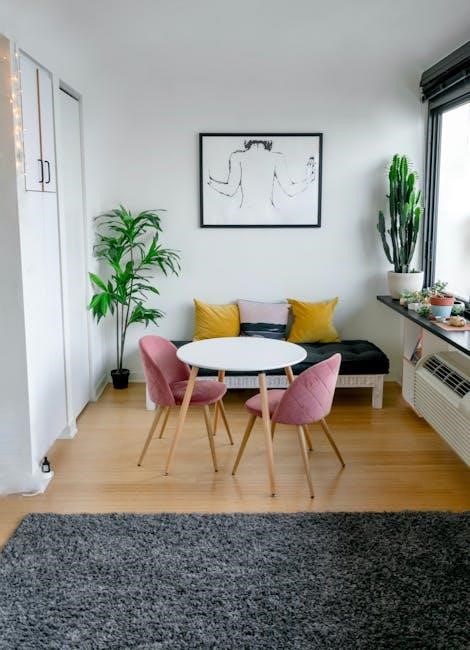
Potting bench plans provide essential guidance for creating a practical workspace for gardeners. These plans often include detailed instructions, materials lists, and step-by-step guides to ensure success. Whether you’re a seasoned gardener or a DIY enthusiast, potting bench plans offer a convenient way to build a durable and functional workspace tailored to your needs.
1.1 What is a Potting Bench?
A potting bench is a specialized workspace designed for gardening tasks like potting, repotting, and seed starting. Typically featuring a sturdy surface and storage compartments, it provides a convenient area to organize tools and supplies. Unlike a standard bench, it often includes features like drainage, shelves, or trays, making it an essential tool for gardeners seeking efficiency and comfort while working with plants.
1.2 Importance of Using Plans for Building a Potting Bench
Using plans for building a potting bench ensures a well-structured and functional design. Plans provide step-by-step instructions, materials lists, and diagrams, helping you avoid costly mistakes. They guide you in creating a sturdy, personalized workspace that meets your gardening needs. With clear instructions, you can achieve professional-grade results, even as a beginner. Plans also help optimize space, ensuring your bench fits perfectly in your garden while offering practical features like storage and durability.
Benefits of Having a Potting Bench
A potting bench offers a dedicated workspace, reducing strain from bending and providing storage for tools. It enhances efficiency and organization, making gardening more enjoyable and productive.
2.1 Convenience and Efficiency in Gardening
A potting bench offers a dedicated workspace, reducing strain from bending over. It streamlines tasks like repotting plants or starting seeds, saving time and effort. With organized storage for tools and supplies, it enhances workflow, making gardening more efficient. The elevated surface minimizes physical strain, allowing for longer work sessions. This practical solution simplifies gardening tasks, ensuring a more enjoyable and productive experience for gardeners of all skill levels.
2.2 Space-Saving Design for Small Gardens
Potting bench plans often incorporate space-saving designs, making them ideal for small gardens. Compact layouts with vertical storage options, such as shelves or cabinets, maximize efficiency. These designs ensure that even limited spaces can accommodate a functional workspace. Many plans include foldable or modular elements, allowing the bench to adapt to your garden’s size. This practical approach ensures that small gardens can still benefit from a dedicated potting area without compromising on style or functionality.
2.3 Aesthetics and Value Addition to Your Garden
A well-designed potting bench enhances your garden’s aesthetics, blending functionality with style. Choose materials like wood or metal to complement your garden’s decor. Customization options allow you to add personal touches, such as paint or decorative trim, making your bench a unique feature. Additionally, a potting bench can increase your garden’s value by providing a practical yet attractive workspace. It becomes a focal point, showcasing your gardening passion while maintaining organization and charm in your outdoor space.
Choosing the Right Potting Bench Plan
Selecting the right plan involves evaluating your garden needs, available space, and desired style. Consider durability, functionality, and personal preferences to find the perfect fit for your gardening goals.
3.1 Assessing Your Garden Needs
Assessing your garden needs is crucial for selecting the right potting bench plan. Consider the space available, the type of gardening activities you’ll perform, and how often you’ll use the bench. If you work with large plants or multiple pots, a sturdy, spacious design is essential. Evaluate your storage requirements for tools and supplies. Mobility may also be a factor if you plan to move the bench around your garden. Tailoring your plan to these needs ensures functionality and satisfaction.
3.2 Popular Styles and Designs
Popular potting bench designs range from rustic to modern, offering functionality and aesthetics. Many plans feature built-in storage, such as shelves or cabinets, while others include space-saving designs for small gardens. Some benches incorporate planters or trays for seeding, adding versatility. Designs often blend practicality with style, using materials like wood or metal. Whether you prefer a classic look or a contemporary feel, there’s a potting bench design to suit every gardener’s needs and enhance their workspace.
3.3 Size and Portability Considerations
When selecting a potting bench plan, consider the size and portability to ensure it fits your garden space and needs. A compact design is ideal for small gardens, while larger benches offer more workspace. Portable benches with wheels or foldable frames provide flexibility, allowing easy relocation. Assessing your available space and how you’ll use the bench will help you choose the right dimensions and style, ensuring functionality without compromising your garden’s layout or accessibility.
Materials Needed for Building a Potting Bench
Essential materials include durable woods like cedar or pine, metal framing, screws, hinges, and weather-resistant hardware. Optional features may include vinyl or plastic for added protection.
4.1 Recommended Woods and Metals
For a durable potting bench, choose rot-resistant woods like cedar or pine. Cedar is ideal for outdoor use due to its natural weatherproofing, while pine offers affordability and ease of work. Metals like galvanized steel or aluminum are excellent for frames, providing strength and rust resistance. Ensure all materials are treated or sealed to withstand moisture and pests, guaranteeing a long-lasting structure for your gardening needs.

4.2 Essential Hardware and Fasteners
Building a potting bench requires sturdy hardware and fasteners to ensure durability. Common items include screws, nails, hinges, and drawer slides for storage compartments. Weatherproof fasteners like galvanized or stainless steel screws are ideal for outdoor use. Additionally, bolts and brackets may be needed for reinforced structures. Ensure all hardware is rust-resistant to withstand moisture and humidity. Properly securing the frame and surfaces with these essentials will guarantee a stable and long-lasting potting bench. Always consult your plan for specific hardware recommendations to match your design.

Tools Required for Assembly
Power tools like circular saws, drills, and sanders are essential for cutting and assembling materials. Hand tools, such as screwdrivers and hammers, are also necessary for final adjustments.
5.1 Power Tools for Cutting and Drilling
Power tools like circular saws and drill presses are essential for cutting lumber and drilling precise holes. A jigsaw or bandsaw can handle curved cuts, while an impact driver efficiently drives screws. Sanders are useful for smoothing wood surfaces. These tools ensure accurate cuts, sturdy joints, and a professional finish. While not all projects require every tool, having the right equipment simplifies the process and guarantees a durable, long-lasting potting bench.
5.2 Hand Tools for Assembly and Finishing
Essential hand tools for assembling and finishing a potting bench include screwdrivers, hammers, tape measures, and clamps. Sandpaper and paintbrushes are crucial for smoothing surfaces and applying finishes. A utility knife can help with cutting materials, while a level ensures everything is properly aligned. Wrenches and pliers may be needed for tightening bolts or adjusting parts. These tools allow for precise assembly and a professional-looking finish, ensuring your potting bench is both functional and visually appealing.

Step-by-Step Guide to Building a Potting Bench
A step-by-step guide to building a potting bench includes preparing materials, assembling the frame, adding the work surface and storage compartments, and applying finishing touches for durability.
6.1 Preparation of Materials
Preparation of materials is crucial for a smooth assembly process. Start by cutting lumber according to the plan’s measurements. Sand all wooden pieces to ensure smooth surfaces. Gather hardware like screws, nails, and hinges. Organize tools such as drills, saws, and wrenches. Double-check the materials list to confirm everything is ready. Proper preparation saves time and reduces errors during assembly. Ensure all components are labeled or sorted for easy access when building the potting bench.
6.2 Assembly of the Frame

Assembling the frame is the foundation of your potting bench. Begin by gathering all pre-cut lumber and hardware. Use power tools to drill pilot holes and secure the legs and supports with screws. Ensure all corners are square and the structure is level. Follow the plan’s instructions for attaching crossbeams and shelves, if included. Double-check measurements for accuracy. This step requires patience and attention to detail to create a sturdy base for your workspace.
6.3 Adding the Work Surface and Storage
Attach the work surface securely, ensuring it is level and sturdy. Add storage compartments like shelves, drawers, or cabinets to keep gardening tools and supplies organized. Incorporate features such as hooks for hanging items or bins for small parts. A smooth, durable work surface is essential for potting and repotting plants. Detailed PDF plans often include diagrams for constructing these elements effectively. This step transforms the frame into a functional workspace tailored to your gardening needs.
6.4 Finishing Touches
After assembling your potting bench, add the final details for a polished look. Sand all surfaces to ensure smoothness, then stain, paint, or seal the wood to protect it from weather. Consider adding a waterproof finish to the work surface for durability. Install any hardware, like hooks or bins, for organization. Finally, apply a clear sealant to repel moisture and extend the bench’s lifespan. These finishing touches enhance both functionality and aesthetics, making your potting bench ready for years of use.

Tips for Building a Durable Potting Bench
Ensure durability by using weather-resistant materials and sealing surfaces. Accurate measurements and proper assembly techniques are crucial for longevity. Regular maintenance will also extend the bench’s lifespan.
7.1 Measuring Accurately
Accurate measuring is crucial when building a potting bench to ensure stability and functionality. Use a tape measure and carpenter’s square to guarantee precise cuts and alignments. Double-check measurements before cutting materials to avoid costly mistakes. Proper alignment ensures the bench is level and sturdy, while accurate cuts prevent uneven surfaces. This attention to detail ensures your potting bench is both durable and functional, making gardening tasks easier and more enjoyable.
7.2 Weatherproofing Your Bench
Weatherproofing your potting bench is essential to ensure durability and protect it from outdoor elements. Use weather-resistant wood, such as cedar or pine, and apply a waterproof sealant or finish. Regularly inspect and maintain the bench to prevent rot or damage. Consider adding a protective roof or cover for extra shield against rain and UV exposure. Proper weatherproofing extends the bench’s lifespan, keeping it functional and sturdy for years of gardening tasks.
Customizing Your Potting Bench
Customize your potting bench with hidden storage compartments and personalized designs. Tailor the bench to fit your gardening needs using the provided PDF plans and creative ideas.
8.1 Adding Storage Compartments
Add functionality to your potting bench by incorporating storage compartments. Shelves, drawers, or cabinets can keep gardening tools and supplies organized. Many PDF plans include designs for hidden storage under the work surface, ensuring your workspace remains clutter-free. Consider adding waterproof liners or sealed containers to protect items from moisture. This feature enhances convenience and makes your potting bench a versatile addition to your garden, blending practicality with efficient organization.
8.2 Personalizing the Design
Personalizing your potting bench allows you to tailor it to your specific needs and preferences. Consider adding unique features like hidden storage compartments, adjustable shelves, or a built-in sink. You can also customize the dimensions, materials, and style to match your garden’s aesthetic. Incorporating personal touches, such as engraved details or a vibrant finish, can make your potting bench truly one-of-a-kind. This customization ensures your workspace is both functional and reflective of your personal style, enhancing your gardening experience.

Budget-Friendly Options
DIY potting bench plans offer cost-effective solutions, with materials often under $40. Opting for simple designs and reclaimed wood can further reduce expenses, making it affordable.

9.1 Cost-Effective Materials
Building a potting bench doesn’t have to break the bank. Cost-effective materials like reclaimed wood, pine, or cedar are excellent choices. Metal frames can also be used for durability. Look for affordable hardware and pre-cut lumber to minimize expenses. Many plans include shopping lists to help you source budget-friendly options. Consider repurposing old pallets or fencing for a rustic, eco-friendly design. These materials ensure your potting bench is both functional and affordable, making your gardening projects more accessible.
9.2 DIY vs. Pre-Built Benches
DIY potting benches offer cost savings and customization, appealing to handy gardeners who enjoy building projects. Pre-built benches provide convenience and durability, ideal for those short on time. DIY options allow personalization at a lower cost but require effort. Pre-built benches are more expensive but offer immediate use and professional craftsmanship. Choose based on your budget, skills, and preferences for the perfect gardening solution.

Maintenance and Upkeep
Regular cleaning and sanitizing are crucial to prevent mold and pests. Use mild detergents and rinse thoroughly to maintain hygiene and functionality.
Inspect and repair any damaged parts promptly to ensure longevity. Replace worn-out components to keep your potting bench sturdy and reliable for years.
Apply weatherproofing treatments periodically to protect the wood or metal from outdoor elements. This helps maintain the bench’s durability and aesthetic appeal over time.
10.1 Cleaning and Sanitizing
Regular cleaning and sanitizing are crucial for maintaining a potting bench. Use mild detergents and water to wipe down surfaces, removing dirt and debris. Avoid harsh chemicals that might harm plants. Rinse thoroughly and let the bench dry to prevent moisture buildup. Sanitize with a solution of water and bleach to eliminate pathogens. Regular maintenance ensures a clean workspace, protecting your plants from diseases and pests. This routine also extends the bench’s lifespan and keeps it functioning effectively for gardening tasks.
10.2 Repairing and Replacing Parts
Regular maintenance ensures your potting bench remains functional. Inspect for worn or damaged parts and replace them promptly. Use weather-resistant materials for longevity. When repairing, follow the original plans for accuracy. Sand and repaint surfaces to protect against decay. Replace loose screws or hinges to maintain stability. For complex repairs, consult the PDF guide for detailed instructions. Proper care extends the bench’s lifespan, keeping it a reliable workspace for years of gardening.
Safety Precautions
Ensure a safe workspace by wearing protective gear and keeping tools organized. Regularly inspect equipment for damage and follow proper lifting techniques to avoid injuries.
Tool Safety Tips: Always unplug power tools when not in use and store them out of reach of children. Maintain a clean workspace to minimize hazards.
11.1 Workspace Safety
Ensuring workspace safety is crucial when building or using a potting bench. Clear the area of debris and tripping hazards, and ensure proper lighting to avoid accidents. Keep tools and materials organized to maintain a clutter-free environment. Use protective gear like gloves and eyewear when cutting or drilling. Ensure the bench is stable and secure to prevent tipping. Additionally, keep children and pets away while working. A safe workspace promotes efficiency and reduces risks of injury or damage.
11.2 Tool Safety Tips
When working with tools to build your potting bench, always wear safety goggles and gloves to protect yourself from debris and sharp edges. Keep tools sharp and well-maintained to avoid accidents. Ensure your workspace is clear of clutter and tripping hazards. Use proper lifting techniques to prevent strain. Never leave power tools unattended, and keep children and pets away. Always follow the manufacturer’s instructions for tool usage and safety guidelines.
Building a potting bench enhances gardening efficiency and organization. With the right plans, you can create a functional workspace tailored to your needs, enjoying a personalized garden setup.
12.1 Recap of Key Points
Potting bench plans offer a comprehensive guide to creating a functional workspace for gardeners. They include detailed instructions, materials lists, and designs to suit various needs. Whether you prefer simple, space-saving options or elaborate setups with storage, these plans ensure durability and efficiency. Customization options allow you to personalize your bench, making it both practical and aesthetically pleasing. By following these plans, you can enhance your gardening experience with a sturdy, well-designed potting bench tailored to your specific requirements.
12.2 Encouragement to Start Your Project
With the wealth of resources available, including detailed PDF plans, there’s no better time to start your potting bench project. Whether you’re a DIY novice or an experienced builder, these guides simplify the process. Take the first step, gather your tools, and transform your garden with a functional and stylish workspace. The sense of accomplishment and the joy of creating something useful will make your effort truly rewarding.

Additional Resources
Find potting bench plans PDFs on platforms like Pinterest, YouTube, and DIY websites. Explore free and paid designs, along with online communities for support and inspiration.
13.1 Where to Find Free and Paid Plans
Free and paid potting bench plans are widely available online. Websites offer downloadable PDF guides with detailed instructions, diagrams, and materials lists. Popular platforms include DIY blogs, gardening forums, and marketplaces like Etsy. Paid plans often include premium features such as customizable designs or hidden storage options. Some retailers, like Aldi, offer affordable pre-made benches. Whether you prefer a simple design or a more complex project, numerous resources are accessible to suit your needs and skill level.
13.2 Online Communities for Support
Online communities are invaluable for support when working with potting bench plans. Forums, social media groups, and specialized DIY platforms offer advice, troubleshooting, and inspiration. Many gardeners share their experiences, providing tips and feedback on various designs. These communities often include free plans, tutorials, and reviews of materials. Engaging with others who have built potting benches can help you avoid common mistakes and refine your project. Joining these groups ensures you have access to a wealth of knowledge and creative ideas to enhance your potting bench.